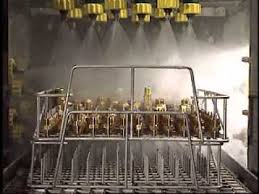 Keep it clean: An intro to parts washers
Keep it clean: An intro to parts washers
March 12, 2015 REDWIRE is news you can use from leading suppliers. Powered by FRASERS.
Posted by Vibra Finish Limited
Vibra Finish Limited is a manufacturer of vibratory finishing, centrifugal finishing, tumbling, separating, vibro-peenin... Read more
Subscribe
Free REDWIRE e-newsletter

Parts cleaning is an essential step in manufacturing, remanufacturing and maintenance processes. To clean effectively, a parts washer is needed — a piece of equipment designed to clean, degrease and dry bulk loads of small or large parts in preparation for assembly, inspection, surface treatment, packaging and distribution. It can also clean fasteners, nuts, bolts and screws, as well as diesel engine blocks and related parts, rail bearings, wind turbine gearboxes and automotive assemblies. Regardless of what’s being cleaned, the process must be done quickly to meet approaching production deadlines.
A parts washer can be as simple as a standalone basket immersion washer, or as complex as a five-step deburring, aqueous tumbling, rinsing, drying and paint coating machine. It is distinctly different from a pressure washer in that parts washers typically clean parts automatically in an enclosed cabinet, while pressure washers typically have a single spray jet mounted at the end of a manually operated wand.
Modern industrial technology makes it possible to combine many parts of the finishing process into one. As an integrated part of the manufacturing process, automatic parts washers are able to load, wash, rinse, dry and unload parts based on a preset computer-controlled program and the help of a conveyor belt to save time, money and man-power, and ensure a quality product. Innovations are being made to ensure parts washers are water and energy saving.
In fact, over the years, many methods of parts cleaning have been developed with improved levels of safety and lessened environmental impact. In the early days, stoddard solvent, gasoline, diesel fuel and kerosene were commonly used to clean and degrease parts. Then, chlorinated solvents in vapour degreasers became an industry standard. During the 1980s, environmental and safety issues led to the banning of chlorinated solvents for parts cleaning. Aqueous-based cleaning systems took on new prominence that led to many improvements in the systems and the processes. In 1971, Gary Minkin developed an aqueous-based parts washer for degreasing automobile parts. The Minkin breakthrough used the force of hydraulic impact pressure to significantly improve the cleaning power of the aqueous parts washer.
To learn more about parts washing, contact Vibra Finish.
Share
Posted by Vibra Finish Limited
Vibra Finish Limited is a manufacturer of vibratory finishing, centrifugal finishing, tumbling, separating, vibro-peenin... Read more